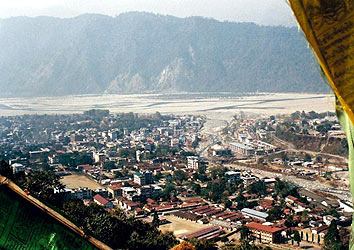 |
Bhutan Agriculture |
|
 |
Bhutan Information |
|
|
 |
| Agriculture |
|
|
Report
on Bhutan's economy 2002 |
A
report released by the national statistical bureau (NSB) says that the
country's economy grew by 6.7 percent in 2002 . NSB is the central apex
body to validate, authenticate and disseminate national statistics to ensure
uniformity in the use of concepts, definitions and classification to enable
comparison of data at the national and international levels.
 |
Gross
domestic product
(GDP) per
capita |
US$
835
|
|
Hydro-power
sector |
10,8
% of GDP
|
|
Agriculture |
33.2
% of GDP
|
|
Construction
sector |
25
% of GDP
|
|
Manufacturing
sector |
7.2
% of GDP
|
Primary
sector
agriculture
and mining |
33.1
% of GDP
|
Secondary
sector
manufacturing,
energy and construction |
33.4
% of GDP
|
Tertiary
sector
service |
33.5
% of GDP
|
| Economic
growth rate |
6.7
%
|
|
Gross
domestic product (GDP)
According
to the NSB's national accounts report 2002, gross domestic product (GDP) climbed to Nu 4,551.0 million from Nu 4,266.0 million in 2001. The per
capita GDP was Nu 40,598 or US$ 835 and gross national product (GNP) per-capita
was Nu 35,954 or US$ 740. Total consumption expenditure - all capital
and consumer goods purchased by government and private - rose by 12 percent
to Nu 18,069.7 million from Nu 16,135.8 million in the previous year.
Total
investment - by government and private in machinery and equipment,
constructions, stocks, etc.- increased by 18.3 percent of which 42 percent
was funded by gross domestic saving and the other 68 percent by grants
and soft loans. In 2002, total investment was Nu 14,469.6 million compared
with Nu 12,311.3 million in the previous year.
Economic
growth rate
However,
the overall economic growth rate fell short of the targeted rate
of 11 percent mainly because of the fall in growth in trade by (-)5.2
percent and in the finance sector by (-)7.2 percent. The negative
growth in the trade was largely due to the September 11 incident in USA
which damaged tourism and related industries like hotels. The decrease
in the finance sector was mainly due to a drop in the oversea interest
earning of RMA by Nu 211.9 million which was in turn hurt by the decline
in the dollar's interest rate, according to the report.
Hydro-power
sector
The
report pointed out that the economy in 2002 was sustained largely by the
additional generation of hydro-power from Kurichu and Basochhu I power
projects of 33.6 million and 110.0 million units. Consequently, the hydro-power
sector grew by 21.8 percent and its share in GDP saw 10.8 percent growth. Agriculture was still dominant with 33.2 percent of the GDP, although in 2002 it grew
by 2.6 percent only. The construction sector which has been robust
for the past four years, saw a growth of 25 percent and its share in the
GDP jumped to 19 percent from 15.1 percent in 2001. The growth was fueled
by huge investment in Tala power project, the low-income housing project
at Thimphu and Phuentsholing, and the Thimphu expressway.
On
the other hand, the manufacturing sector which has been on the downslide
since 1996 grew by a paltry 0.4 percent with 7.2 percent share in the GDP.
The
share of the primary sector - agriculture and mining- in the GDP
has declined from 56.3 percent in 1980 to 33.1 percent in 2002 while the
share of the secondary sector - manufacturing, energy and construction-
has increased to 33.4 percent in 2002 from 11.4 percent in 1980. The tertiary
or service sector has not changed much though. It's contribution to
GDP in the last 22 years from 1980 has barely been over one percent to
33.46 percent in 2002.
|



